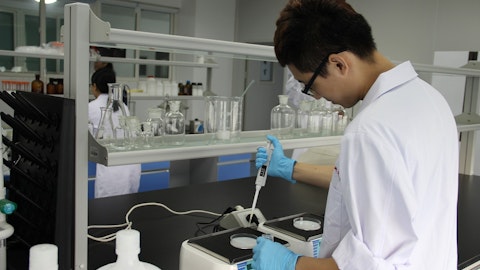Oncolytics Biotech Inc. (NASDAQ:ONCY) Q1 2025 Earnings Call Transcript May 14, 2025
Oncolytics Biotech Inc. beats earnings expectations. Reported EPS is $-0.06, expectations were $-0.09.
Operator: Good afternoon, and welcome to Oncolytics Biotech First Quarter Conference Call. All participants are in a listen-only mode. There will be a question-and-answer session at the end of the call. Please be advised that this call is being recorded at the Company’s request. I would now like to turn the call over to Jon Patton, Director of Investor Relations and Communications. Please go ahead.
Jon Patton: Thank you, operator. Today, we’ll provide an update on the quarter and a review of our financials. As a reminder, various remarks made during this call contain certain forward-looking statements relating to the Company’s business prospects and the development and commercialization of pelareorep, including statements regarding the Company’s ongoing CEO search, or emission strategies and milestones, the Company’s belief as to the potential and mechanism of action of pelareorep as a cancer therapeutic or potential registrational opportunities for pelareorep, and our plans and strategies related thereto; our plans to continue enrollment in GOBLET Cohort 5, our ongoing business development initiatives and other statements related to anticipated developments in the Company’s business.
These statements are based on management’s current expectations and beliefs and are subject to a number of factors which involve known, unknown risk, delays, uncertainties and other factors not under the Company’s control that may cause actual results, performance or achievements of the Company to be materially different from the results, performance or expectations implied by these forward-looking statements. In any forward-looking statement, which Oncolytics expresses an expectation or belief as to future results, such expectations or beliefs are expressing good faith and are believed to have a reasonable basis, but there can be no assurance that these statements or expectations or belief will be achieved. These factors include results of current pending clinical trials, risks associated with intellectual property production, financial projections, actions by regulatory agencies and those other factors detailed in the Company’s filings with SEDAR and the SEC.
Oncolytics does not undertake any obligation to update these forward-looking statements, except as required by applicable laws. On today’s call, I’m joined by Chair of Oncolytics’ Board of Directors and Interim CEO, Wayne Pisano; Chief Medical Officer; Dr. Tom Heineman; VP Business Development; Christophe Degois; and Chief Financial Officer, Kirk Look. The team will be available for Q&A at the end of this call. And with that, I’ll hand it over to Wayne.
Wayne Pisano: Good afternoon, everyone, and thank you, Jon. I know it’s only been a short time since we last provided a corporate update so today’s call will be relatively brief. I’ll run through the important developments from the quarter and then ask Tom to discuss our clinical progress and Christophe to share our business development update. Then Kirk will say a few words about our financials. To start, I want to let you know that our CEO search is active, and we’ve met several excellent candidates with an asset like pelareorep, which has potential in numerous consequential indications, we are aiming to find a leader who can steward pela with a laser focus on clinical trial execution. Our clinical data continues to exceed expectations and we believe the further development of pela will allow it to fulfill its potential as a value of treatment option for patients with several difficult-to-treat malignancies, including pancreatic cancer, breast cancer and anal carcinoma.
All of which have a high unmet medical need. Additionally, the new CEO will provide invaluable leadership and strategic decision-making surrounding our plant registration-enabling study evaluating pela and paclitaxel in advanced or metastatic HR-positive/HER2-negative breast cancer. And I hope to be able to announce our new CEO in the near future. Pelareorep or pela, as we often call it, is a unique and versatile immunotherapeutic agent that we believe has tremendous potential to help a wide range of cancer patients. As discussed during a key opinion leader event in March, Professor, Alexander Eggermont described pela’s benefits, including intravenous administration, the ability to be taken to tumor sites via monocytes and lymphocytes, and that it doesn’t create anti-agent antibodies, allowing T cells to reach the tumor for long-lasting responses, all without infecting normal healthy cells.
During the same call, Professor, Martine Piccart, a leading expert in breast cancer, shared her experience in the clinic and confirmed intravenous administration is much referred to any intratumoral interventions. She also discussed pela’s opportunity in breast cancer and the multitude of registrational opportunities for an asset like pela. She confirms support for the continued advancement of pela-based on two randomized studies confirming its ability to provide an overall survival benefit in breast cancer. She also discussed her belief that there could be an opportunity for pela to benefit patients at an earlier stage of treatment, possibly in a curative setting. Additionally, in the first quarter, we were able to showcase the versatility of pela in gastrointestinal cancers when we presented data at ASCO GI in both pancreatic and anal cancers.
Tom will lead the discussion of that clinical data shortly. Looking forward, we’ll be sharing pancreatic cancer data at this year’s ASCO meeting, highlighting pela’s unique mechanism of action, which stimulates both innate and adaptive immune responses. I’d now like to turn the call over to Tom for an update on our clinical progress and plans. Tom?
Dr. Tom Heineman: Thanks, Wayne, and thanks for teeing up the data that we have shared and we’ll be sharing this year of medical conferences such as ASCO and ASCO GI. The impactful data that Wayne mentioned was presented in January of this year at the ASCO GI conference. Interim results from GOBLET Cohort 4, which investigates pela and atezolizumab in relapsed anal carcinoma showed a 33% objective response rate, including one patient with a complete response that lasted more than 15 months. We have expanded this cohort to Stage 2 in which an additional 18 patients will be enrolled. If the efficacy signal in this cohort persists, we will engage in discussions with our scientific advisory board and key opinion leaders to optimize the development of pela in this indication.
While anal carcinoma is not as large a commercial opportunity as breast or pancreatic cancer, achieving regulatory approval in this indication would serve as an important validation of pela’s potential in gastrointestinal cancers and could greatly benefit patients with a very high unmet medical need. In addition, GOBLET Cohort 5, which is funded by a $5 million grant from the Pancreatic Cancer Action Network, or PanCAN is currently enrolling newly diagnosed metastatic pancreatic cancer patients. This cohort is evaluating pela combined with modified FOLFIRINOX with or without atezolizumab. Enrollment into the safety run-in phase of this cohort was recently completed. After a review of the safety data by an independent data safety monitoring board in the German regulatory authorities, we received all necessary permissions to proceed with full enrollment, which is ongoing.
This cohort has enrolled more than half of the patients required to complete Stage 1 of the study, which requires a total of 30 evaluable patients, 15 each in the arm with the atezolizumab and the arm without the atezolizumab. Upon completion of Stage 1 enrollment, the decision will be made whether to advance either one or both arms to Stage 2 enrollment. If the efficacy data are encouraging, this study could lead to yet another registrational opportunity. We expect to review initial efficacy data from this cohort later this year and shared publicly next year. In addition to the exciting progress in our gastrointestinal cancer studies, I’d also like to remind you of the compelling breast cancer results from two randomized Phase 2 studies, in which pela-based combination therapy substantially outperformed standard of care treatment.
The first of these was the IND-213 study in metastatic breast cancer in which median overall survival in the pela group was nearly double that in the control arm. We followed IND-213 with the BRACELET-1 study to confirm the efficacy signal. In BRACELET-1, we evaluated patients with advanced or metastatic HR-positive/HER2-negative breast cancer who had progressed on hormonal therapy, including a CDK4/6 inhibitor. The BRACELET-1 data became available last fall and showed a substantial clinical benefit for pela combined with paclitaxel compared to paclitaxel monotherapy. This was based on a near doubling of both the median progression-free survival and the two-year survival rate a near tripling of the confirmed objective response rate and a median overall survival of more than a year longer than that in the control arm, with two randomized Phase 2 studies pointing to a meaningful clinical benefit as well as supportive mechanism of action data from several studies, including the AWARE-1 breast cancer trial.
We believe we have largely derisked this program, setting the stage for continued development of pela in breast cancer. In the evolving breast cancer treatment landscape, we have a number of attractive options for the continued development of pela. These include a potential registration-enabling study designed to take advantage of the accelerated approval pathway which was successfully utilized by breast cancer drugs such as Pfizer’s Ibrance and Daiichi’s in HER2. We also have the option to conduct studies in patients at different stages in the breast cancer treatment path including patients with inoperable disease who have failed antibody drug conjugate therapy and early-stage patients utilizing a neoadjuvant approach. This latter is one of the pathways suggested by key opinion leaders including Professor, Martine Piccart, who spoke at the KOL event, Wayne mentioned at the start of this call.
Next, I would like to introduce Christophe, who will comment on our ongoing business development activities. Christophe?
Christophe Degois: Thanks, Tom. I’m happy to share an update on our BD activities in addition to development involving our current collaboration. As we discussed, the data presented at ASCO GI continued to show the versatility of pela in multiple indications, specifically pancreatic or anal cancer. One underappreciated aspect is a remarkable safety profile of pela. Pela has been administered to over 1,100 patients over the course of its development. While we are encouraged to see there remain no safety concern in anal cancer where pela is being evaluated with the checkpoint inhibitor atezolizumab is now being tested in combination with modified FOLFIRINOX in pancreatic cancer. This chemotherapy regimen has a different safety profile than gemcitabine plus nab-paclitaxel, the chemotherapy regimen from Cohort 1 of the GOBLET study.
The fact that we are able to combine pela with multiple chemotherapies and checkpoint inhibitors while maintaining a favorable safety profile in pancreatic cancer makes it easier to engage in productive BD conversation. We had encouraging business development interaction in January at the JPMorgan Conference and will continue to meet with potential biopharma partners at ASCO in Chicago and Bio in Boston. We’re also supported by key opinion leaders like Professor Martine Piccart and Professor Alex Eggermont, will continue to be enthusiastic supporters of pela’s potential. During the previously discussed KOL event organized by H.C. Wainwright, both Professor Piccart and Professor Eggermont, highlighted the need for new treatment innovations such as pela that work to activate the immune system to recognize and kill cancer.
Furthermore, we already have support from advocacy groups like PanCAN while funding Cohort 5 as a GOBLET study. As I mentioned on our previous calls, the accompanying data pela has generated across multiple indication serves us well. We have two randomized Phase 2 studies, showing pela’s benefits in HR-positive/HER2-negative metastatic breast cancer, multiple pancreatic studies pointing to pela’s meaningful impact and an emerging efficacy signal that’s continued to persist in anal cancer. In summary, this continues to be an exciting time for pela as we evaluate the most efficient way to pursue regulatory approval and further demonstrate the potential of our unique immunotherapeutic asset as in helping improve the lives of cancer patients. I look forward to our next chance to update you on our BD opportunities and activities.
I’ll now turn the presentation over to Kirk, who will discuss our financials for the quarter. Kirk?
Kirk Look: Thanks, Christophe, and good afternoon, everyone. I’d like to discuss our financial results for the first quarter of 2025, which will be provided in Canadian dollars unless otherwise noted. A full summary of our financial results can be found on the Investors section of our website on their filings and reports or in the press release issued earlier this afternoon. Turning to our financial results for the first quarter. As of March 31, 2025, we reported cash and cash equivalents of $15.3 million, providing runway through key value-driving milestones and through the third quarter of 2025. Net cash used in operating activities for the quarter were $6.5 million compared to $7.5 million in the same period last year. The decrease reflects lower net operating expenditures, partially offset by changes in noncash working capital.
General and administrative expenses were $3 million for the first quarter, consistent with the prior year. Research and development expenses totaled $4.1 million, down from $5.7 million in Q1 of 2024. This decrease is primarily driven by reduced manufacturing and clinical trial costs, partially offset by increased personal-related and share-based compensation expenses associated with leadership transition activities. The net loss for the quarter was $6.7 million or $0.08 per basic and diluted share compared to a net loss of $6.9 million, $0.09 per share in Q1 of 2024. Finally, following the end of our quarter, we were pleased to announce a $20 million share purchase agreement with Alumni Capital. This agreement provides the Company with access to capital solely at our discretion, helping us extend our financial runway.
Now, this concludes our financial review. We look forward to providing further updates throughout the year and encourage you to watch for our upcoming poster presentation on pela’s mechanism election at ASCO. On behalf of the entire Oncolytics team, I’d like to thank our patients, caregivers, health care providers, employees and shareholders for their ongoing support. Now, I would like to open the call for Q&A. Operator?
Q&A Session
Follow Oncolytics Biotech Inc (NASDAQ:ONCY)
Follow Oncolytics Biotech Inc (NASDAQ:ONCY)
Receive real-time insider trading and news alerts
Operator: Thank you. Ladies and gentlemen, we will now begin the question-and-answer session. [Operator Instructions] Your first question comes from the line of Patrick Trucchio from H.C. Wainwright. Please go ahead.
Patrick Trucchio: Congrats on all the progress. Just first, regarding the anticipated start of the registrational trial in HR-positive/HER2-negative metastatic breast cancer. What can you share about the potential trial design for the study. Will PFS be a primary endpoint? And how are you incorporating feedback from regulatory agencies? And then separately, have there been any recent interactions with the FDA or other regulatory bodies regarding the pancreatic cancer program? And what feedback, if any of you received concerning potential registrational pathways.
Dr. Tom Heineman: Hi, Patrick, Tom Heineman here. Maybe I can answer those and others can step in if there’s more to say. Regarding on the breast cancer side, we, as you know, have discussed the study with the FDA at a Type C meeting in second or third quarter of last year, right? We continue to — beg your pardon, we continue to work towards the initiation of our next study in breast cancer. At the time that we discussed this with the FDA, we obviously discussed many elements of the study design, including the primary endpoint, which we do anticipate will be progression-free survival in our next breast cancer study. So that’s on the breast cancer side. On the pancreatic cancer side, we have not had, I mean, we have — the FDA is aware of our pancreatic cancer program, including having granted us fast-track approval in pancreatic cancer.
We have been working with GCAR, as you may be aware, to develop a protocol in pancreatic cancer and those — that activity is ongoing. Of course, we’re talking to key opinion leaders and exploring all the best options in our pancreatic cancer program forward, but we have not had any additional discussions with the FDA recently, if we were to move forward with the registrational study through any means that would require an FDA meeting before we initiated that study, however. I hope that answered your question. Maybe if I forgot anything, let me know.
Patrick Trucchio: Yes, that’s helpful. And then just a follow-up, if I may, on the business development activities. I’m wondering if there are specific areas like regional rights or co-development opportunities or other areas that are being prioritized? And then just given pelareorep’s mechanism of action, are there plans to explore additional combination approaches maybe with immune checkpoint inhibitors or in other tumor types?
Christophe Degois: Hi, Patrick, this is Christophe. Yes, I’m happy to answer the first question. I think Tom can comment on the second part of the question because we’re already doing that. Yes. What we’re doing right now, as we mentioned, we’ve been busy at JPMorgan, we’ll be at ASCO, we’ll be at BIO. We are looking at different — potential different partnership for us, what’s very important is, as we discussed during this call, pela has potential multiple indications. So, we’d like to have obviously, breast and pancreatic being our top priorities. So, we’d like a partner that could help us maximize the value of the asset in this multiple indication. And that could be done either through a global partnership or more regional like European partnership. So, we are looking at both avenues right now. Does that answer your question?
Patrick Trucchio: Yes, that’s helpful.
Christophe Degois: Tom, do you want to comment, yes, do you want to comment on the combination?
Dr. Tom Heineman: Yes, yes, sure. If you don’t mind, Patrick, I’ll just mention the combination with checkpoint inhibitors specifically. So, we’ve done a lot of work, translational work based on samples from clinical trials in a number of different indications, including breast and pancreatic cancer and have shown particularly in pancreatic cancer, but also in breast cancer, the pela clearly potentiates the activity of checkpoint inhibitors, right? Now in breast cancer, we have seen very strong efficacy data with pela without a checkpoint inhibitor. So, it’s not necessarily essential in every context. But in pancreatic cancer, specifically, we have really solid clinical and translational data indicating a synergy with checkpoint inhibitors. So, this is something that we will continue to explore and leverage on an indication-by-indication basis.
Operator: [Operator Instructions] Your next question comes from the line of Michael Freeman from Raymond James. Please go ahead.
Michael Freeman: So, a few questions here. You mentioned on the metastatic breast program. You’ve previously discussed a registration path that might enable accelerated approval. And then I think I’m hearing for the first time discussion of treatment of patients at different stages of the treatment journey and leaning towards earlier-stage patients, if I’m hearing it — if I heard it right. I wonder if you could discuss — just like to dive into that a little more. Is this — would this be an alternative to do a registration-enabling trial? Or would this be like a separate cohort along the treatment journey? Please discuss the rationale and different potential registration paths.
Dr. Tom Heineman: Yes, Tom here. So just to be clear, we’re not trying to imply that we would be shifting towards earlier stage necessarily. I’m just trying to indicate that there are a lot of different populations in the breast cancer treatment path that could provide valuable information and advanced the overall program and one of those may be an earlier stage study in neoadjuvant patients. But the other thing to consider is that the antibody drug conjugates, as you’re certainly aware, are changing the landscape in breast cancer. This provides us with a real opportunity because following antibody-drug conjugate therapy, the treatment for these patients is much less clear and is wide open for agents like pela-based combination therapy to step in.
And so, they’re in some discussing with key opinion leaders, there is a sense that one potential way to advance the program and derisk it and move it forward efficiently would be to specifically generate in patients who have who are — these are not earlier-stage patients, but these are patients who have failed hormonal therapy and then also failed at antidrug conjugate. We have every reason to believe that pela would be a successful agent in that patient population and generating direct data in that population could be a very nice way to further derisk the program and also stimulate additional interest by potential partners, investors and so forth who are looking to understand as well as possible where pela could fit into the overall treatment path.
I hope that answers your question, and I don’t know if anyone else on the call may want to contribute to that answer.
Kirk Look: Yes. That’s helpful. Just a little more on that. I’m curious, like was that not similar to the what you had contemplated for the original registration-enabling trial like that it would line up after ADCs? Or is — or are you now sort of considering a smaller cohort study that would exclusively look at post-ADC or like patients that had failed hormonal therapy and the ADCs?
Dr. Tom Heineman: Yes, we had anticipated that before. The reality of the matter is that at that time, it was more hypothetical because the ADCs had been approved as the first line therapy immediately following failure on hormonal therapy, right? Now with that approval, I don’t remember when that was the first quarter of this year. With that approval now on the books, that opens up a slightly different population and leads us to expect that the ADCs are going to be used even earlier in the treatment path than had been obvious before, right? And so, provides us with some additional opportunity and motivation to further solidify that pela’s efficacy in that population. You see what I’m saying, and if we were to go down that path, we certainly would do it in a smaller study, but we wouldn’t do it in a tiny study.
We definitely want to make sure that the data that we’ve generated there are robust enough to really move the program for us rapidly and with this little risk as possible.
Michael Freeman: Okay. All right. Great. I appreciate you guys being a dynamic of the landscape. Now, I have a question for Kirk. On the share purchase agreement. Congratulations on finding that access to capital. I wonder if you could describe just like the basic structure of this agreement, any terms, conditions, benefits to Alumni Capital? And just like the flexibility that offers you?
Kirk Look: Yes, for sure, Michael. I think essentially, the share purchase agreement does provide us with access to capital at our discretion. Importantly, the minimum purchase notice is set at the 750,000 often what we see are smaller purchase notices moving forward. So, we felt that, that was important. The structure in terms of commitment fees. There was an upfront commitment fee that was granted and then there is an additional fee that’s attached on a pro rata basis, as well in an effort to reduce the cost of capital, which we were pleased with. And so, it really allows us to — based on kind of the market dynamics at the time allows us a source of capital that we can at our discretion, take advantage of and allows us to move the programs forward. Get us through our milestones, especially around the GOBLET study that’s coming up here and get through this CEO transition and importantly, move the runway forward.
Michael Freeman: Okay. All right. That’s helpful. Have you tapped that since announcing it?
Kirk Look: We are — yes, we’ve tapped it a little bit. But again, we’re just making sure that it works as described, and we’re doing it in a in a strategic manner.
Operator: Thank you. There are no further questions at this time. I would now hand the call back to Mr. Kirk Look for any closing remarks.
A – Kirk Look: Well, thanks, operator. Once again, I would like to thank everyone for taking the time to hear about our recent progress and plans for the future. We continue to be excited about 2025 and how pela is positioned to positively impact the lives of cancer patients. Wishing everyone a great day. Thanks very much.
Operator: And this concludes today’s call. Thank you for participating. You may all disconnect.
Follow Oncolytics Biotech Inc (NASDAQ:ONCY)
Follow Oncolytics Biotech Inc (NASDAQ:ONCY)
Receive real-time insider trading and news alerts





